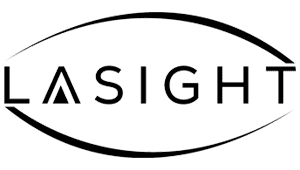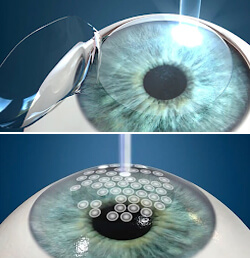What are the odds of eliminating my glasses?
At LA Sight, 100% of patients will see well enough without glasses to pass the DMV eye test (“20/40”). Just under 30% achieve 20/15 or better acuity, while 98.3% achieve 20/20 or better vision. The results are better for patients with lower amounts of correction. See our
LASIK Results section.
Does the treatment hurt?
With both PRK and LASIK, there is no pain or discomfort at the time of surgery, as anesthetic eye drops are used. With LASIK, there may be a mild foreign body sensation for several hours after care, accompanied by a lot of tearing. After that, there should be no discomfort at all. After PRK, there can be mild to moderate discomfort for 1-3 days. The discomfort is minimized by use of a ‘band-aid’ soft contact lens and special eye drops. When epithelial healing is complete, the lens is removed, there is no further risk of discomfort. With LASIK, many patients observe that they experience no pain, no irritation, and not even any slight foreign body or ‘eyelash’ sensation. Most are pleasantly surprised at how little discomfort they had, and usually mention this when they talk about their experience.
Can I lose vision as a result of this treatment?
This is one of the most important concerns that patients have. No patient in our practice has ever lost their vision, or suffered any untoward accident or misadventure leading to blindness (or even serious vision compromise) as a result of laser treatment. No patient in any of the extensive FDA studies of excimer laser treatment has suffered profound vision loss. In the entire world experience, we are aware of an extremely small number of cases (approximately one per million surgeries performed) that have caused serious eye or vision problems. That includes surgeries done by untrained or ill-trained surgeons, experimental and “off-brand” lasers, and so forth. It is the general consensus among very experienced, competent US and European surgeons that this should not happen in the hands of good surgeons doing good work with proper equipment.
Is this a “no-risk” procedure?
No surgical procedure is without risk. We take risk every day when we get out of bed, walk across a street, drive a car, or fly in an airplane. We consider these “acceptable” risks and a part of modern life. There are certain risks involved in taking any action (such as having LASIK) and there are risks involved in not taking action. For example, there is a small risk of blindness associated with use of soft contact lenses (due to amebic corneal infection in perhaps 1 per million contact lens wearers), and risk of serious eye injury if glasses are worn and facial trauma occurs. This latter risk is also in the range of the “one in a million”.
What about long-term results?
The long-term stability of laser vision surgery is remarkable. In our practice, we have seen patients retain excellent unaided vision (in the range of “20/20” and even “20/15”) for over a decade. Laser vision correction is at least 1,000 times more accurate, and more stable, than any prior corrective surgery ever performed, including radial keratotomy (“RK”). Excimer laser surgery was first performed in 1988. Extensive testing around the world has confirmed that there are no long-term health problems to the eye from this type of care.
Will my eyes deteriorate in the future?
Most people see the eye doctor for a checkup and prescription update every one to three years. It is normal for a person’s optical prescription to change a very small amount every several years. The reason for this is explained in the Refractive Drift section of our “Advanced Optical Issues” page. This slow rate of change “drift” of the prescription through life is not worsened, nor is it eliminated, by having LASIK. After LASIK, if the eyes change, the change will be very slight and should stay close to “zero prescription” point where you want them!
What if I move during the procedure?
Many patients worry about this, and the concern is sometimes substantial. Almost everyone moves a tiny bit during the procedure. Under the laser microscope, a person’s face and eyes can move (slightly) in concert with normal breathing. This is why we perform every surgery with “assisted stabilization” to assure ideal rendering and centration of the laser treatment, and/or we use lasers with pupil-tracking systems. Also, we can pause the laser treatment whenever we want, and resume when it is safe, stable, and proper to do so.
What if I blink when they’re doing the laser?
The eyelids are gently held apart during the laser treatment by a special instrument, which feels a little odd, but doesn’t typically hurt.
Will I need to wear an eye patch after the procedure?
No. Some patients are given a “band-aid” contact lens overnight to promote healing.
If I don’t get a full correction, will I be able to have a repeat procedure to improve the results?
Approximately 3% of our patients return for an enhancement procedure. These patients have had a dramatic improvement in their vision, but have not achieved a “perfect” correction. After LASIK, a “touch-up” or “enhancement” is even easier than the original treatment, because we can find and carefully lift the original flap.
What are the common problems and complications?
By far the most common issue is under-correction or over-correction. In this case, vision will be “good, but not perfect.” Further laser treatment, known as an “enhancement” or a “touch-up”, can improve the vision further by treating the remaining optical imperfection. About 20% of patients can experience optical consequences during the healing process, including glare, halos at night, or ghost images. In almost all cases, these disappear within several weeks or months. Careful attention to detail in centration and calibration of the laser, as well as measurement of pupil size, substantially lessens the incidence of these problems.
How many people have had PRK and LASIK?
It is estimated that more than 25 million people worldwide have had laser vision care; about 50% of these were performed in the U.S. However, as we stress to each patient, what matters most are your own eyes and the results in your own case, not the number of patients that have gone before you.
How soon can I return to work and other activities?
The answer is different for PRK and LASIK. We recommend a return to full work activities no sooner than about 3 days after PRK. For that reason, most people choose to have their PRK on a Thursday or Friday. With LASIK, my experience has been that many patients often feel so good the day after surgery that they feel like going right back to work. It would not be realistic to promise that everyone will feel perfect the next day after LASIK, but certainly the overwhelming majority of individuals I have cared for have expressed this sentiment. Almost all other activities including strenuous exercise, reading, and even driving at night are OK as soon as you feel comfortable.
Can my results be guaranteed?
As in any medical intervention, especially any type of surgery or laser therapy, there can be no guarantee of results in any specific case. We work extremely hard to see that each person we care for gets the maximum possible benefit. Even though the laser treatment is exquisitely precise and our experience is quite significant, variations in final visual result can arise due to individual variations in healing, and to other factors.
Will the treatment cause cataracts, or influence the treatment of cataracts?
No. Laser corrective treatment does not cause cataracts, and does not affect the removal of cataracts.







